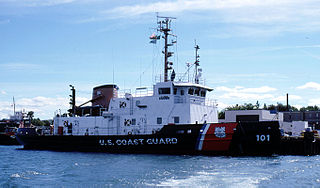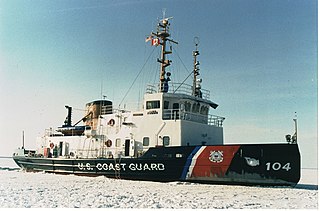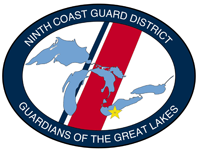
USCGC Acushnet (WMEC-167) was a cutter of the United States Coast Guard, homeported in Ketchikan, Alaska. She was originally USS Shackle (ARS-9), a Diver-class rescue and salvage ship commissioned by the United States Navy for service in World War II. She was responsible for coming to the aid of stricken vessels and received three battle stars during World War II, before a long career with the Coast Guard. Acushnet patrolled the waters of the North Pacific and was one of the last World War II era ships on active duty in the US fleet upon her retirement in 2011.

USCGC Mackinaw (WAGB-83) is a 290-foot (88 m) former Coast Guard icebreaker on exhibit as a museum ship at the Icebreaker Mackinaw Maritime Museum in Mackinaw City, Michigan. The vessel has been known as the "Queen of the Great Lakes" and "The Largest Icebreaker on the Great Lakes"; the site states that "she was built during World War II to meet the heavy demands of war materials and transportation during the winter months".

The Bay-class tugboat is a class of 140-foot (43 m) icebreaking tugboats of the United States Coast Guard, with hull numbers WTGB-101 through to WTGB-109.

USS Edisto (AGB-2) was a Wind-class icebreaker in the service of the United States Navy and was later transferred to the United States Coast Guard as USCGC Edisto (WAGB-284). She was named after Edisto Island, South Carolina. The island is named after the Native American Edisto Band who inhabited the island and the surrounding area. As of 2011 there is a namesake cutter USCGC Edisto (WPB-1313). The newer Edisto is a 110-foot Island-class patrol boat and is stationed in San Diego County, California.

USCGC Bramble (WLB-392) is one of the 39 original 180-foot (55 m) seagoing buoy tenders built between 1942 and 1944 for the United States Coast Guard. In commission from 1944 until 2003 she saw service in Pacific, Caribbean and Atlantic waters as well as the Great Lakes. In 1947 Bramble was present at the Nuclear testing at Bikini Atoll and in 1957 a circumnavigation of North America involved a forced traverse of the Northwest Passage. After decommissioning in 2003 Bramble became a museum ship in Port Huron, Michigan. In 2018 she was sold to a private owner, who is preparing MV Bramble to repeat her historic 1957 circumnavigation of North America.

The USCGC Morgenthau (WHEC-722), was the eighth of twelve 378-foot dual-powered turbine/diesel Hamilton-class high endurance cutters (WHECs) built by Avondale Shipyards in New Orleans, Louisiana. The Coast Guard commissioned the Morgenthau on March 10, 1969. After 48 years of continuous service the U.S. Coast Guard decommissioned the Morgenthau on April 18, 2017, and the ship was sold to Vietnam. On 27 May 2017 the Vietnam Coast Guard commissioned the former cutter as patrol craft CSB-8020.

Franklin A. Welch was the ninth Master Chief Petty Officer of the United States Coast Guard. Welch entered the Coast Guard in 1980 after graduating from Shades Valley High School Class of 1978, in Birmingham, Alabama. A former Master Chief Quartermaster, he served in office from October 10, 2002, to June 14, 2006, and served in the Coast Guard for over 26 years.

USCGC Forward (WMEC-911) is a United States Coast Guard medium endurance cutter. Named for Walter Forward, fifteenth United States Secretary of the Treasury, she was constructed by Robert Derecktor Shipyard Incorporated, Middletown, Rhode Island was delivered in May 1989, and commissioned 4 August 1990. USCGC Forward (WMEC-911) and USCGC Legare (WMEC-912) were commissioned in a joint ceremony in Portsmouth, Virginia.

USCGC Vigorous (WMEC-627) is a United States Coast Guard Reliance Class medium endurance cutter.

USCGC Swivel (WYTL-65603) was one of fifteen 65-foot steel-hulled harbor tugs, that entered service with the United States Coast Guard in the 1960s. Each was built to replace the 64-foot wooden-hulled harbor tugs built during the 1940s.

USCGC Sturgeon Bay is the newest of the United States Coast Guard 140-foot (43 m) Bay-class cutters. Homeported in Bayonne, New Jersey, the primary missions of Sturgeon Bay and her crew are Domestic Icebreaking and Ports, Waters, & Coastal Security. During the winter months, Sturgeon Bay is responsible for providing search and rescue capabilities to the ice-covered areas in New York City and the Hudson Valley, as well as throughout coastal New England. The cutter also facilitates the safe navigation of commercial product, including gasoline and heating oil, through the ice-choked Hudson River from New York City to Albany. All Bay-class cutters, including Sturgeon Bay, use a low-pressure-air hull lubrication or bubbler system that forces air and water between the hull and ice. This system improves icebreaking capabilities by reducing resistance against the hull, reducing horsepower requirements.

USCGC Katmai Bay (WTGB-101) is a United States Coast Guard Cutter, and the lead ship of the Bay-class of icebreaking tugboats. At 140 ft (43 m), she is designed to have greater multi-mission capabilities than the 110' Calumet-class Harbor Tug (WYTM). She is homeported in Sault Ste Marie, Michigan, operating in support of the much larger USCGC Mackinaw (WLBB-30).

USCGC Biscayne Bay (WTGB-104) is a United States Coast Guard Cutter and an icebreaking tug. She is based at Coast Guard Station St. Ignace with a primary area of operation in the Straits of Mackinac including Mackinac Island, Mackinac Bridge, and the northern portions of Lakes Michigan and Huron and occasionally Lakes Superior, Erie and their connecting rivers. Beyond her role as an icebreaker, Biscayne Bay performs search and rescue and law enforcement functions.

USCGC Smilax (WAGL/WLIC-315) is a 100-foot (30 m) United States Coast Guard Cosmos-class inland construction tender, commissioned in 1944. Smilax is the "Queen of the Fleet", as the oldest commissioned U.S. Coast Guard cutter.

District 9 is a United States Coast Guard district, based at the Anthony J. Celebrezze Federal Building, in Cleveland, Ohio. District 9 is responsible for all Coast Guard operations on the five Great Lakes, the Saint Lawrence Seaway, and surrounding states accumulating 6,700 miles of shoreline and 1,500 miles of international shoreline with Canada.

USCGC Penobscot Bay is the seventh of nine United States Coast Guard 140-foot Bay-class icebreaking tugs. Homeported in Bayonne, New Jersey, the primary missions of Penobscot Bay and her crew are Domestic Icebreaking and Ports, Waterways, & Coastal Security. During the winter months, Penobscot Bay is responsible for providing search and rescue capabilities to the ice-covered areas in New York City and the Hudson Valley, as well as throughout coastal New England. The cutter also facilitates the safe navigation of commercial product, including gasoline and heating oil, through the ice-choked Hudson River from New York City to Albany. All Bay-class cutters, including Penobscot Bay, use a low-pressure-air hull lubrication or bubbler system that forces air and water between the hull and ice. This system improves icebreaking capabilities by reducing resistance against the hull, reducing horsepower requirements.
Bay City Marine Incorporated is a shipbuilder based in National City, California near San Diego.

USCGC Bristol Bay (WTGB-102) is the second vessel of the Bay-class tugboats built in 1978 and operated by the United States Coast Guard. The ship was named after the body of water formed by the Alaskan peninsula, which emptied into the Bering Sea.

USCGC Neah Bay (WTGB-105) is the fifth vessel of the Bay-class tugboat built in 1980 and operated by the United States Coast Guard. The ship was named after a bay located within the state of Washington and bordered by Puget Sound.

USCGC Morro Bay (WTGB-106) is the sixth vessel of the Bay-class tugboats built in 1980 and operated by the United States Coast Guard. The ship was named after a seaside city in San Luis Obispo County, California.


















